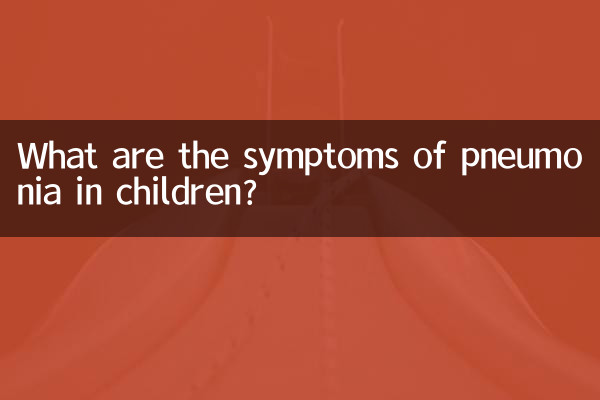What are the symptoms of pneumonia in children?
Recently, with the seasonal changes and the high incidence of influenza, pneumonia in children has become a hot topic of concern to parents. Pneumonia is a common respiratory infection in children, especially in children under 5 years old. Understanding the early symptoms, prevention and treatment of pneumonia is crucial to protecting your child's health. The following is a summary and structured analysis of the symptoms of pneumonia in children among hot topics on the Internet in the past 10 days.
1. Common symptoms of pneumonia in children

Symptoms of pneumonia vary depending on age, pathogen and severity of illness, but the following are typical:
| Symptom classification | Specific performance | Remarks |
|---|---|---|
| respiratory symptoms | Cough (may be accompanied by phlegm), shortness of breath, wheezing, chest pain | Infants and young children may show nodding breathing or nose flaring |
| systemic symptoms | Fever (body temperature ≥38°C), fatigue, decreased appetite | Some children may be asymptomatic |
| Other symptoms | Vomiting, diarrhea, restlessness | Newborns may simply refuse milk or be lethargic |
2. Differences in symptoms among different age groups
Symptoms of pneumonia in children vary significantly with age, so special attention should be paid to:
| age group | Typical symptoms | red flag |
|---|---|---|
| Newborn (0-28 days) | Unstable body temperature, milk refusal, and apnea | Need immediate medical attention |
| Infant (1-12 months) | Respiratory rate >50 times/min, three concave signs | Cyanosis may occur |
| Toddlers (1-3 years old) | High fever lasting for more than 3 days and listlessness | Be wary of severe pneumonia |
| Preschoolers (3-6 years old) | Chest pain and cough worsening | May express symptoms |
3. Warning symptoms that require emergency medical treatment
When the following conditions occur, it indicates a critical condition and requires immediate medical attention:
1.Abnormal breathing:The respiratory rate increases significantly (neonates > 60 times/min, infants > 50 times/min, and older than 1 year old > 40 times/min), and moaning, cyanosis or apnea occur.
2.Circulatory symptoms:Increased heart rate (infants >160 beats/min, young children >140 beats/min), cold limbs, and capillary refill time >2 seconds.
3.Neurological symptoms:Drowsiness or restlessness, convulsions, and disturbance of consciousness.
4.Others:Refusal to eat or urine output is significantly reduced, and body temperature does not rise (<36°C).
4. Discussion of recent popular preventive measures
According to recent hot discussions on the Internet, key measures to prevent pneumonia in children include:
| Precautions | Specific methods | effectiveness |
|---|---|---|
| Vaccination | Pneumococcal vaccine, influenza vaccine, Hib vaccine | May reduce risk of severe disease |
| Daily protection | Wash your hands frequently, wear a mask, and avoid crowded places | Basic protection measures |
| Enhance immunity | Balanced diet, moderate exercise, and adequate sleep | Effective for a long time |
| environmental management | Keep indoor ventilation and humidity 40%-60% | Reduce the spread of pathogens |
5. Answers to frequently asked questions by parents
1.Q: How to distinguish between the common cold and pneumonia?
A: Pneumonia usually has longer fever duration (>3 days), faster respiratory rate, and worse mental status. Colds are mostly characterized by upper respiratory tract symptoms such as runny nose and sneezing.
2.Q: Is coughing with phlegm necessarily pneumonia?
A: Not necessarily. Diseases such as bronchitis can also cause phlegm cough, which needs to be judged based on other symptoms and auscultation by a doctor.
3.Q: Do I need antibiotics for pneumonia?
A: Viral pneumonia does not require antibiotics, but bacterial pneumonia does. The cause needs to be determined through routine blood tests, CRP and other tests.
4.Q: Is pneumonia contagious?
A: Some pathogens (such as pneumococci and influenza viruses) are contagious and require isolation and protection.
In summary, the symptoms of pneumonia in children are diverse, and parents should closely observe key indicators such as respiratory rate and mental state. Early identification of severe symptoms, prompt medical treatment, and cooperation with doctors to complete standardized treatment are the keys to ensuring the recovery of children. At the same time, good vaccination and daily protection can significantly reduce the risk of pneumonia.

check the details

check the details